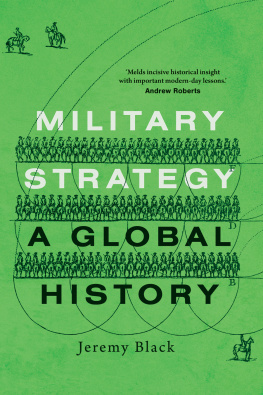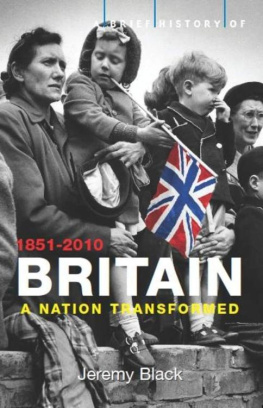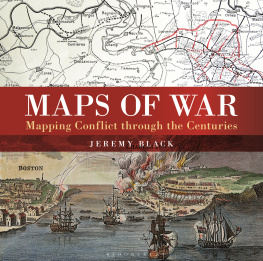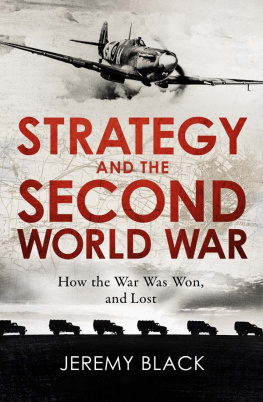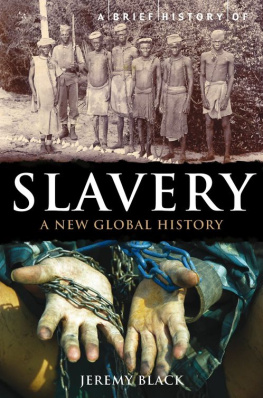Jeremy Black - A Short History of War
Here you can read online Jeremy Black - A Short History of War full text of the book (entire story) in english for free. Download pdf and epub, get meaning, cover and reviews about this ebook. year: 2021, publisher: Yale University Press, genre: History. Description of the work, (preface) as well as reviews are available. Best literature library LitArk.com created for fans of good reading and offers a wide selection of genres:
Romance novel
Science fiction
Adventure
Detective
Science
History
Home and family
Prose
Art
Politics
Computer
Non-fiction
Religion
Business
Children
Humor
Choose a favorite category and find really read worthwhile books. Enjoy immersion in the world of imagination, feel the emotions of the characters or learn something new for yourself, make an fascinating discovery.
- Book:A Short History of War
- Author:
- Publisher:Yale University Press
- Genre:
- Year:2021
- Rating:4 / 5
- Favourites:Add to favourites
- Your mark:
- 80
- 1
- 2
- 3
- 4
- 5
A Short History of War: summary, description and annotation
We offer to read an annotation, description, summary or preface (depends on what the author of the book "A Short History of War" wrote himself). If you haven't found the necessary information about the book — write in the comments, we will try to find it.
A Short History of War — read online for free the complete book (whole text) full work
Below is the text of the book, divided by pages. System saving the place of the last page read, allows you to conveniently read the book "A Short History of War" online for free, without having to search again every time where you left off. Put a bookmark, and you can go to the page where you finished reading at any time.
Font size:
Interval:
Bookmark:
A SHORT HISTORY OF WAR

Copyright 2021 Jeremy Black
All rights reserved. This book may not be reproduced in whole or in part, in any form (beyond that copying permitted by Sections 107 and 108 of the U.S. Copyright Law and except by reviewers for the public press) without written permission from the publishers.
For information about this and other Yale University Press publications, please contact:
U.S. Office:
Europe Office:
Set in Minion Pro by IDSUK (DataConnection) Ltd
Printed in Great Britain by TJ Books, Padstow, Cornwall
Library of Congress Control Number: 2021937081
e-ISBN 978-0-300-26295-7
A catalogue record for this book is available from the British Library.
10 9 8 7 6 5 4 3 2 1
For Virgilio Ilari
Contents
Acknowledgements
I would like to thank Heather McCallum for her backing for this project and, in doing so, mark three decades of working together. Caleb Karges, Heiko Henning and three anonymous readers provided very helpful comments on an earlier draft. They are not responsible for any errors that remain. Charlotte Chapman has proved an excellent copy-editor. This book is dedicated to Virgilio Ilari, a key figure in keeping the academic study of military history vibrant and intellectually rigorous, and a much-valued supporter of my work.
CHAPTER 1
The Origins of Conflict
If we forbear to fight, it is likely that some great schism will rend and shake the courage of our people till they make friends of the Medes [Persians]; but if we join battle before some at Athens be infected by corruption, then let Heaven but deal fairly with us, and we may well win in this fight.
H erodotus dramatic account of Miltiades the Younger outlining in 490 BCE what was at stake for Athens when threatened by a Persian invasion, the threatening great power of its day, captured the role of will and the place of divine support in understandings of success in warfare. This remark from the ancient world, however, is one that in terms of the species is really that of very recent history. Humans from the outset were involved in conflict, but not on any great scale, and certainly not that of the 490 BCE invasion that culminated with the total Athenian victory at the Battle of Marathon over the larger Persian force.
Instead, humans had to compete with other animals for food and to prevent themselves from being food for others. They also had to fight for shelter. Warfare did not therefore only emerge as some result of the corruption of humankind by society, in the shape of agriculture and related social organisation, as was enthusiastically argued in the 1960s by commentators who were unconsciously copying Judaeo-Christian ideas of the Fall of Man due to Adams sin. Such an account would have warfare begin about 90 per cent of the way into our history as a species. Instead, fighting is integral to human society. Indeed, the pattern for modern hunter-gatherer societies, such as those in Amazonia and New Guinea, reflects a formerly more common practice, notably of conflict between human groups, whether hunter-gatherers or settled. Fighting with other human groups, whether to secure hunting areas, to seize slaves, not least for mates and/or to incorporate into the tribe, or to assert masculinity, was part of a continuum with fighting with animals. Indeed, the last bear in Germany was not killed until 1797.
The success of humans over animals in the conflict that has lasted across human history, and which continues today in new forms with creatures that cannot be seen with the naked eye, owed much to inherent physical and mental characteristics, but also to humans ability to use these to improve their chances. Physically, a key factor was that of being able to perspire and move at the same time, rather than having, as with many animals, to stop in order to perspire. This capability provided a major advantage in both pursuit and flight.
The ability to communicate through language was vital in helping humans to hunt and fight as groups. A significant ability in resisting other predators, and in hunting megafauna, notably mastodons and mammoths, group activity could then be translated to conflict with other humans. Language was also important in helping ensure that innovations spread and were improved.
This was a key aspect of the learning process that has remained significant to the present day, and that helped differentiate humans from other fighting animals. This process was not some automatic response to circumstances or an unconscious process of evolution, but, instead, a matter of testing opportunities and evaluating responses, with humans acting as agents of change. This was a process in which social organisation and language played roles and in which humans differentiated from other species.
A major, but not sole, aspect of this was the development of tools as the properties offered by stone, wood, bone, hide, antler, fire and clay were used to create and strengthen both weapons and shelters. Flint stones proved particularly useful, notably for axe heads, and techniques of working on them improved. Composite tools, particularly points and blades mounted in wood or bone hafts, were especially important, and spears and arrows were stone-tipped, providing greater penetrative power for the weight.
Throwing weapons helped humans overcome animals with stronger combat characteristics, including innate weapons and protection, especially claws, antlers, tusks and hides. Humans needed weapons to keep outside the range of the animals. Moreover, tools, such as large stone points able to pierce mammoth hides, made it possible not only to kill but also to cut up bodies and thus eat them, gaining protein accordingly. Protein from meat and fish did not require the long processing needed to digest raw vegetables and fruits.
In Europe, large megafauna, including sabre-toothed tigers, giant deer and the woolly rhinoceros, all became extinct, as in Central America did mastodons and giant armadillos. Changing habitats were doubtless important, but so was the ability of humans to exploit the situation. Their skill in hunting helped ensure that humans were better able than other animals to adapt to the unpredictability and possibilities created by the retreat of the ice sheets at the end of the last Ice Age in around 10,000 BCE . Thus, the population of the woolly rhinoceros, which appears to have been essentially stable from about 27,000 BCE to about 16,500 BCE while humans were present, possibly because the rhinoceros was too dangerous to hunt, fell from 12,700 BCE , possibly due to the consequences of global warming, before the species became extinct.
Taima-Taima, a site in coastal Venezuela with human occupation back to 12,20010,980 BCE , has yielded a mastodon bone pierced by spear point. A burial pit recently found in Alaska revealed the bones from humans who died about 9500 BCE , laid on a bed of antler points and weapons. Humans fighting animals were widely depicted in early rock paintings in caves, as later in Roman mosaics. In Spain, the rock paintings in Cueva de la Vieja show men with bows hunting stags, while rock art from the Tassili nAjjer plateau in the Sahara, dating from about 6000 BCE , present the hunting of giraffes, and in Kashmir, the Burzahama site from about 4300 BCE depicts hunters and a bull. Hunting is also a key element in Mayan art in Central America. So also with stories about humans and animals fighting, stories found in all mythologies.
The range of human capabilities assisted in the struggle with other carnivores, in the domestication of some animals that enhanced human capabilities, notably in agriculture and movement, and in creating a safe context for a new stage of human action upon the land in the shape of cultivation of crops and the related development of permanent settlements. The timetable varied by region, in part due to the spread of innovations, but also to the density of humans, to the routes between their groups, and to terrain, cover and the differing impact of the Ice Ages. Diversity owed a great amount to the physical environment, but humans could affect this, notably with the clearing of woodland for agriculture, which also reduced the cover for wild animals. The development of harpoons and bows and arrows helped in catching fish, as did the adaptation of boats to particular maritime environments, for example
Next pageFont size:
Interval:
Bookmark:
Similar books «A Short History of War»
Look at similar books to A Short History of War. We have selected literature similar in name and meaning in the hope of providing readers with more options to find new, interesting, not yet read works.
Discussion, reviews of the book A Short History of War and just readers' own opinions. Leave your comments, write what you think about the work, its meaning or the main characters. Specify what exactly you liked and what you didn't like, and why you think so.



